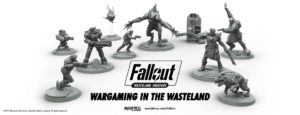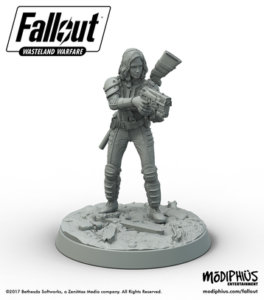Fallout: Wasteland Warfare – Development Blog 3: Effect Dice
Posted by James (admin) on August 16th, 2017
 In this development blog about Fallout: Wasteland Warfare game from Modiphius, we’re looking at the Effect dice that often accompany a Skill roll.
In this development blog about Fallout: Wasteland Warfare game from Modiphius, we’re looking at the Effect dice that often accompany a Skill roll.
Whenever a skill roll is made, like shooting or lockpicking, you roll the d20 Skill dice to see if it is a success; however, depending on the equipment, abilities, perks, mods, etc. being used, you might also roll some Effect dice as part of the skill roll too.
There are four different Effect dice in Fallout: Wasteland Warfare – Damage, Accuracy, Armour Reduction, and Special – each is a different colour and these are d12s. Why d12s? Well, six sides on a dice just didn’t give enough granularity and/or variety to the outcomes for them to accomplish what was required, and twelve sides gives lots of different possible probabilities (plus, d12s are nice and big with large faces for icons too).
When you make a roll, you grab the Skill dice and the relevant Effect dice which are easy to recognise as each dice type is a different colour, and coloured icons for each dice are shown on the card of each weapon, equipment, mod, etc. Your weapon shows two black dice? Just grab two black dice and the skill dice. As with the measurement sticks, the dice icons have markers which allow players with colour-blindness to recognise what they need too.
Let’s go into a bit more detail about the different types by looking at them in relation to combat. Unsurprisingly, the Damage dice primarily causes extra damage – note that this is extra damage as each weapon deals a guaranteed amount of damage (called it’s base damage) and any extra damage from the Effect dice (one for each damage icon rolled) is on top of the base damage. This means the damage caused by weapons has a level of reliability, rather than be at the full mercy of the dice and see your missile launcher hit but only scratch the target when you roll a 1.
 The Accuracy dice primarily improve your chances of the Skill dice being a success. Many sides of the Accuracy dice have a number which improve the Skill dice. If your skill roll needs to be 3 or less then you would succeed if your Skill dice was a 5 and you rolled -2 on an Accuracy dice as that would bring it down to 3 which is a success – you just combine what you see.
The Accuracy dice primarily improve your chances of the Skill dice being a success. Many sides of the Accuracy dice have a number which improve the Skill dice. If your skill roll needs to be 3 or less then you would succeed if your Skill dice was a 5 and you rolled -2 on an Accuracy dice as that would bring it down to 3 which is a success – you just combine what you see.
The Armour Reduction dice, as you may expect, primarily reduces a target’s armour rating – one for each icon rolled. We’ll discuss how armour works in a blog post soon, but suffice to say that the Armour Reduction icons can strip away a target’s armour, potentially allowing more damage to get through – pretty important when up against opponents in power armour.
The final Effect dice is the Special dice. This is a generic dice that covers anything the first three do not. It shows three different icons with the one icon having a high chance, another a medium chance, and another a low chance of success. When a roll requires these icons, the cards say what the icons are required and what they can be used for. For example, does the Laser Rifle set fire to the target? Did the Huge Club stun the enemy? and so on. This allows Fallout: Wasteland Warfare to have Effect dice for any purpose.
Of course, only expecting the best in the Wasteland will likely get you killed and the Effect dice are no different. There are no ‘bad’ results on any Effect dice, but some sides are blank so will have no effect at all. Also, note how I said the dice ‘primarily’ do something? That’s because Effect dice have the occasional result that are not the dice’s primary purpose; for example, it is possible to get an Armour Reduction icon on a Damage dice, although it’s rare and most results do extra damage. The icons tell the story of what happened too – rather than just doing damage, you’ll know if an attack just felled the Super Mutant was because of the heavy damage or because the shot managed to find a way past its armour.
Effect Dice and Weapons
The Effect dice required for a weapon often vary depending on the range at which the weapon is being used. For example, the Hunting Rifle gives one Armour Reduction dice at short range, but at long range it gives two Accuracy dice instead. The Combat Shotgun gives no Effect dice at long range, but gives a frightening two black dice at short range. Simply seeing a weapon’s Effect dice makes it easy to understand its likely capabilities – a weapon with multiple black dice on its card means it has the potential to do lots of damage. Also, the Effect dice on a weapon card may not be the only Effect dice you add to a skill roll too. Items such as Mod cards (which are modifications to weapons), special abilities, perks, and so on, can add more dice (or simply add extra icons). More on those in a later blog post.
Whilst Effect dice are a common feature of combat, they apply to all areas of Fallout: Wasteland Warfare too. Some locks are hard to pick, computers difficult to hack, and items tricky to find, but equipment and abilities can add Effect dice to these skill rolls too in order to succeed at these more difficult tasks.
The two-player starter set comes with 2 each of the four Effect Dice, one Skill dice and one Armour dice. The system and combination of Effect Dice gives us a huge variety of options to flavour the game to feel more like the Fallout world you know and love, whilst keeping the results of dice rolls quick and simple to read.
Remember, if you’re interested in receiving news on the game, sign-up for the official updates from Modiphius. Plus, you can visit the Modiphius site to check out all the great-looking models and their status.
More news to come and I’m looking forwards to sharing more details,
James.
Please note that due to the amount of spam comments bots try and post, all comments have to be manually approved so there can be a time delay to your post becoming visible. It’s often quicker to post on the Modiphius Fallout Forum or Fallout: Wasteland Warfare page on BoardGameGeek.com where I or someone else can answer your questions.

